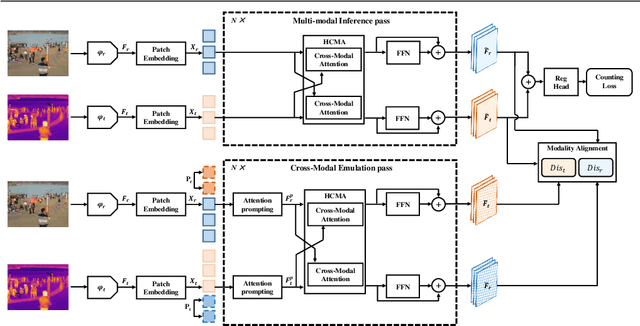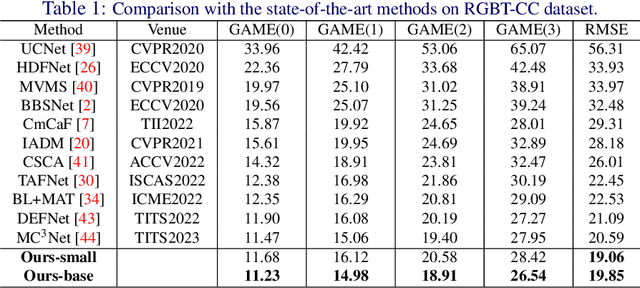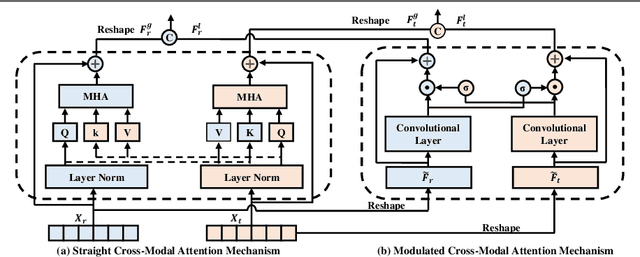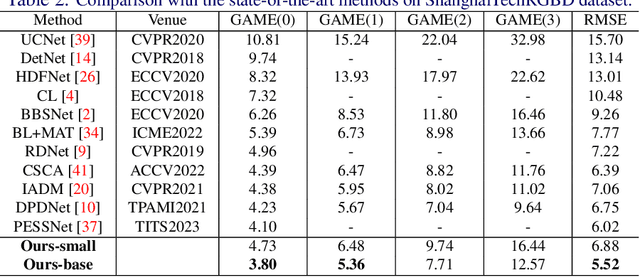Zhiheng Ma
DD-Ranking: Rethinking the Evaluation of Dataset Distillation
May 19, 2025Abstract:In recent years, dataset distillation has provided a reliable solution for data compression, where models trained on the resulting smaller synthetic datasets achieve performance comparable to those trained on the original datasets. To further improve the performance of synthetic datasets, various training pipelines and optimization objectives have been proposed, greatly advancing the field of dataset distillation. Recent decoupled dataset distillation methods introduce soft labels and stronger data augmentation during the post-evaluation phase and scale dataset distillation up to larger datasets (e.g., ImageNet-1K). However, this raises a question: Is accuracy still a reliable metric to fairly evaluate dataset distillation methods? Our empirical findings suggest that the performance improvements of these methods often stem from additional techniques rather than the inherent quality of the images themselves, with even randomly sampled images achieving superior results. Such misaligned evaluation settings severely hinder the development of DD. Therefore, we propose DD-Ranking, a unified evaluation framework, along with new general evaluation metrics to uncover the true performance improvements achieved by different methods. By refocusing on the actual information enhancement of distilled datasets, DD-Ranking provides a more comprehensive and fair evaluation standard for future research advancements.
CoGenAV: Versatile Audio-Visual Representation Learning via Contrastive-Generative Synchronization
May 06, 2025Abstract:The inherent synchronization between a speaker's lip movements, voice, and the underlying linguistic content offers a rich source of information for improving speech processing tasks, especially in challenging conditions where traditional audio-only systems falter. We introduce CoGenAV, a powerful and data-efficient model designed to learn versatile audio-visual representations applicable across a wide range of speech and audio-visual tasks. CoGenAV is trained by optimizing a dual objective derived from natural audio-visual synchrony, contrastive feature alignment and generative text prediction, using only 223 hours of labeled data from the LRS2 dataset. This contrastive-generative synchronization strategy effectively captures fundamental cross-modal correlations. We showcase the effectiveness and versatility of the learned CoGenAV representations on multiple benchmarks. When utilized for Audio-Visual Speech Recognition (AVSR) on LRS2, these representations contribute to achieving a state-of-the-art Word Error Rate (WER) of 1.27. They also enable strong performance in Visual Speech Recognition (VSR) with a WER of 22.0 on LRS2, and significantly improve performance in noisy environments by over 70%. Furthermore, CoGenAV representations benefit speech reconstruction tasks, boosting performance in Speech Enhancement and Separation, and achieve competitive results in audio-visual synchronization tasks like Active Speaker Detection (ASD). Our model will be open-sourced to facilitate further development and collaboration within both academia and industry.
ComprehendEdit: A Comprehensive Dataset and Evaluation Framework for Multimodal Knowledge Editing
Dec 17, 2024



Abstract:Large multimodal language models (MLLMs) have revolutionized natural language processing and visual understanding, but often contain outdated or inaccurate information. Current multimodal knowledge editing evaluations are limited in scope and potentially biased, focusing on narrow tasks and failing to assess the impact on in-domain samples. To address these issues, we introduce ComprehendEdit, a comprehensive benchmark comprising eight diverse tasks from multiple datasets. We propose two novel metrics: Knowledge Generalization Index (KGI) and Knowledge Preservation Index (KPI), which evaluate editing effects on in-domain samples without relying on AI-synthetic samples. Based on insights from our framework, we establish Hierarchical In-Context Editing (HICE), a baseline method employing a two-stage approach that balances performance across all metrics. This study provides a more comprehensive evaluation framework for multimodal knowledge editing, reveals unique challenges in this field, and offers a baseline method demonstrating improved performance. Our work opens new perspectives for future research and provides a foundation for developing more robust and effective editing techniques for MLLMs. The ComprehendEdit benchmark and implementation code are available at https://github.com/yaohui120/ComprehendEdit.
FLAME: Frozen Large Language Models Enable Data-Efficient Language-Image Pre-training
Nov 18, 2024Abstract:Language-image pre-training faces significant challenges due to limited data in specific formats and the constrained capacities of text encoders. While prevailing methods attempt to address these issues through data augmentation and architecture modifications, they continue to struggle with processing long-form text inputs, and the inherent limitations of traditional CLIP text encoders lead to suboptimal downstream generalization. In this paper, we propose FLAME (Frozen Large lAnguage Models Enable data-efficient language-image pre-training) that leverages frozen large language models as text encoders, naturally processing long text inputs and demonstrating impressive multilingual generalization. FLAME comprises two key components: 1) a multifaceted prompt distillation technique for extracting diverse semantic representations from long captions, which better aligns with the multifaceted nature of images, and 2) a facet-decoupled attention mechanism, complemented by an offline embedding strategy, to ensure efficient computation. Extensive empirical evaluations demonstrate FLAME's superior performance. When trained on CC3M, FLAME surpasses the previous state-of-the-art by 4.9\% in ImageNet top-1 accuracy. On YFCC15M, FLAME surpasses the WIT-400M-trained CLIP by 44.4\% in average image-to-text recall@1 across 36 languages, and by 34.6\% in text-to-image recall@1 for long-context retrieval on Urban-1k. Code is available at \url{https://github.com/MIV-XJTU/FLAME}.
Multi-modal Crowd Counting via Modal Emulation
Jul 28, 2024



Abstract:Multi-modal crowd counting is a crucial task that uses multi-modal cues to estimate the number of people in crowded scenes. To overcome the gap between different modalities, we propose a modal emulation-based two-pass multi-modal crowd-counting framework that enables efficient modal emulation, alignment, and fusion. The framework consists of two key components: a \emph{multi-modal inference} pass and a \emph{cross-modal emulation} pass. The former utilizes a hybrid cross-modal attention module to extract global and local information and achieve efficient multi-modal fusion. The latter uses attention prompting to coordinate different modalities and enhance multi-modal alignment. We also introduce a modality alignment module that uses an efficient modal consistency loss to align the outputs of the two passes and bridge the semantic gap between modalities. Extensive experiments on both RGB-Thermal and RGB-Depth counting datasets demonstrate its superior performance compared to previous methods. Code available at https://github.com/Mr-Monday/Multi-modal-Crowd-Counting-via-Modal-Emulation.
Reshaping the Online Data Buffering and Organizing Mechanism for Continual Test-Time Adaptation
Jul 12, 2024



Abstract:Continual Test-Time Adaptation (CTTA) involves adapting a pre-trained source model to continually changing unsupervised target domains. In this paper, we systematically analyze the challenges of this task: online environment, unsupervised nature, and the risks of error accumulation and catastrophic forgetting under continual domain shifts. To address these challenges, we reshape the online data buffering and organizing mechanism for CTTA. We propose an {uncertainty-aware buffering approach} to identify {and aggregate} significant samples with high certainty from the unsupervised, single-pass data stream. {Based on this}, we propose a graph-based class relation preservation constraint to overcome catastrophic forgetting. Furthermore, a pseudo-target replay objective is used to mitigate error accumulation. Extensive experiments demonstrate the superiority of our method in both segmentation and classification CTTA tasks. Code is available at \href{https://github.com/z1358/OBAO}{this https URL}.
Curriculum Dataset Distillation
May 15, 2024



Abstract:Most dataset distillation methods struggle to accommodate large-scale datasets due to their substantial computational and memory requirements. In this paper, we present a curriculum-based dataset distillation framework designed to harmonize scalability with efficiency. This framework strategically distills synthetic images, adhering to a curriculum that transitions from simple to complex. By incorporating curriculum evaluation, we address the issue of previous methods generating images that tend to be homogeneous and simplistic, doing so at a manageable computational cost. Furthermore, we introduce adversarial optimization towards synthetic images to further improve their representativeness and safeguard against their overfitting to the neural network involved in distilling. This enhances the generalization capability of the distilled images across various neural network architectures and also increases their robustness to noise. Extensive experiments demonstrate that our framework sets new benchmarks in large-scale dataset distillation, achieving substantial improvements of 11.1\% on Tiny-ImageNet, 9.0\% on ImageNet-1K, and 7.3\% on ImageNet-21K. The source code will be released to the community.
Prompt Customization for Continual Learning
Apr 28, 2024



Abstract:Contemporary continual learning approaches typically select prompts from a pool, which function as supplementary inputs to a pre-trained model. However, this strategy is hindered by the inherent noise of its selection approach when handling increasing tasks. In response to these challenges, we reformulate the prompting approach for continual learning and propose the prompt customization (PC) method. PC mainly comprises a prompt generation module (PGM) and a prompt modulation module (PMM). In contrast to conventional methods that employ hard prompt selection, PGM assigns different coefficients to prompts from a fixed-sized pool of prompts and generates tailored prompts. Moreover, PMM further modulates the prompts by adaptively assigning weights according to the correlations between input data and corresponding prompts. We evaluate our method on four benchmark datasets for three diverse settings, including the class, domain, and task-agnostic incremental learning tasks. Experimental results demonstrate consistent improvement (by up to 16.2\%), yielded by the proposed method, over the state-of-the-art (SOTA) techniques.
Few-shot Online Anomaly Detection and Segmentation
Mar 27, 2024



Abstract:Detecting anomaly patterns from images is a crucial artificial intelligence technique in industrial applications. Recent research in this domain has emphasized the necessity of a large volume of training data, overlooking the practical scenario where, post-deployment of the model, unlabeled data containing both normal and abnormal samples can be utilized to enhance the model's performance. Consequently, this paper focuses on addressing the challenging yet practical few-shot online anomaly detection and segmentation (FOADS) task. Under the FOADS framework, models are trained on a few-shot normal dataset, followed by inspection and improvement of their capabilities by leveraging unlabeled streaming data containing both normal and abnormal samples simultaneously. To tackle this issue, we propose modeling the feature distribution of normal images using a Neural Gas network, which offers the flexibility to adapt the topology structure to identify outliers in the data flow. In order to achieve improved performance with limited training samples, we employ multi-scale feature embedding extracted from a CNN pre-trained on ImageNet to obtain a robust representation. Furthermore, we introduce an algorithm that can incrementally update parameters without the need to store previous samples. Comprehensive experimental results demonstrate that our method can achieve substantial performance under the FOADS setting, while ensuring that the time complexity remains within an acceptable range on MVTec AD and BTAD datasets.
Semi-supervised Counting via Pixel-by-pixel Density Distribution Modelling
Feb 23, 2024



Abstract:This paper focuses on semi-supervised crowd counting, where only a small portion of the training data are labeled. We formulate the pixel-wise density value to regress as a probability distribution, instead of a single deterministic value. On this basis, we propose a semi-supervised crowd-counting model. Firstly, we design a pixel-wise distribution matching loss to measure the differences in the pixel-wise density distributions between the prediction and the ground truth; Secondly, we enhance the transformer decoder by using density tokens to specialize the forwards of decoders w.r.t. different density intervals; Thirdly, we design the interleaving consistency self-supervised learning mechanism to learn from unlabeled data efficiently. Extensive experiments on four datasets are performed to show that our method clearly outperforms the competitors by a large margin under various labeled ratio settings. Code will be released at https://github.com/LoraLinH/Semi-supervised-Counting-via-Pixel-by-pixel-Density-Distribution-Modelling.
 Add to Chrome
Add to Chrome Add to Firefox
Add to Firefox Add to Edge
Add to Edge